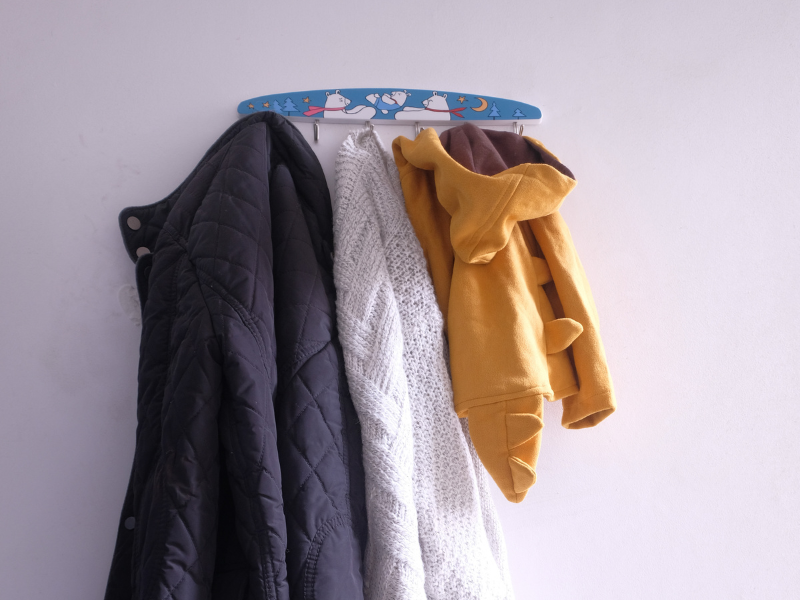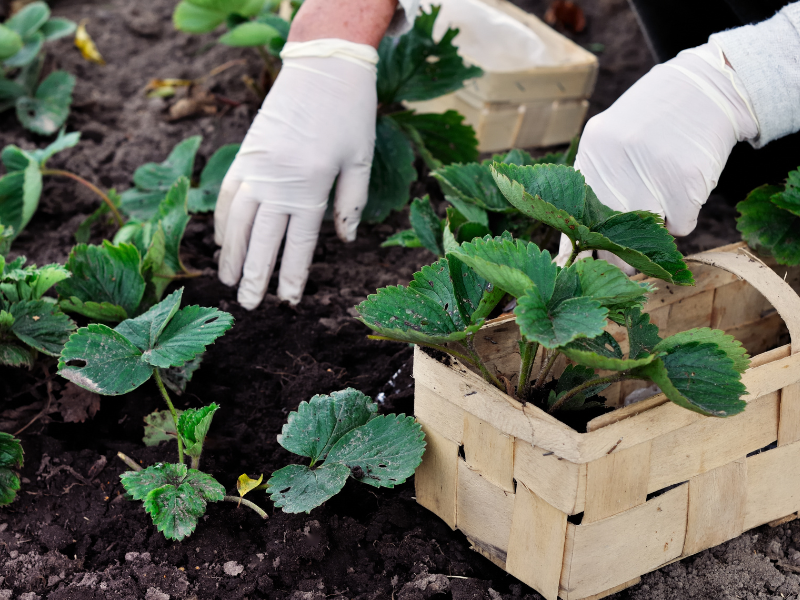

Russian Verbs of Placement – класть/положить, ставить/поставить, вешать/повесить, сажать/посадить
Ah, the delightful complexities of the Russian language! We all know it’s a linguistic labyrinth, especially when it comes to verbs. Today, we’re diving headfirst into Russian verbs of placement. This article is the second part of my Russian Verbs of Position & Placement series. In my previous article, “Russian Verbs Of Position: Сидеть Лежать Стоять Висеть” we learned all about what positions objects take and which verbs to use to describe their static positions. But if the question popped up in your head . . . “But how did they get there?” then this article will explain that!
Get ready to unravel the tangled web of класть/положи́ть, ста́вить/поста́вить, ве́шать/пове́сить, and сажа́ть/посади́ть. These verb pairs allow you to describe the lying down of, putting, placing, hanging, planting and sitting down of objects in Russian!
Want to practice common collocations after you’ve finished the article?
Check out my Quizlet flashcards set!
Russian Verbs of Placement: класть / положить, ставить / поставить, вешать / повесить, сажать / посадить

What are Verbs of Placement?
Verbs of placement, as you might have guessed from the name, describe the placing of a direct object. The reason this is a complex topic for Russian language learners is because there are several verbs we can use depending on the position they take once they’ve been placed. Here they are:
класть/положи́ть
ста́вить/поста́вить
ве́шать/пове́сить
сажа́ть/посади́ть





How do Verbs of Position differ from Verbs of Placement?
If you’ve read the first part in this series: “Russian Verbs Of Position: Сидеть Лежать Стоять Висеть”, you have the first piece of the puzzle in understanding the various ways objects can be placed. If you haven’t read that article yet, I highly recommend doing so! Anyway, shameless plug aside, verbs of placement are much easier to understand once you’ve got an understanding of the positions objects take.
We use the verb лежа́ть if an object “lies” (i.e. is located in a horizontal position and does not have a base or a foundation holding it up). In order to describe the action that puts that object in its lying position, we use the Russian verb of placement класть/положи́ть.


We use the verb стоя́ть if an object “stands” (i.e. is in an upright, standing position or has a base or a foundation). In order to describe the action that puts that object in its standing position, we use the Russian verb of placement ста́вить/поста́вить.


We use the verb висе́ть if an object “hangs” (i.e. is in a hanging position off the ground). In order to describe the action that puts that object in its hanging position, we use the Russian verb of placement ве́шать/пове́сить.


We use the verb сиде́ть if an object “sits” (i.e. is in an upright, sitting position on a surface). In order to describe the action that puts that object in its sitting position, we use the Russian verb of placement сажа́ть/посади́ть.


*Note: Whereas Russian verbs of position answer the question где? (where?), Russian verbs of placement answer the question куда? (to where?)
Now that you’ve got the gist, let’s go into some more detail on the individual Russian verbs of placement!





Russian Verbs of Placement – класть / положить, ставить / поставить, вешать / повесить, сажать / посадить
1. класть/положи́ть (+кого́/что +куда́?): to put, place down in a lying position
We use класть/положи́ть when we put something in a lying position. If the object uses the verb of position лежа́ть (+где?), then to place it somewhere, you must use класть/положи́ть.
This verb pair is also used for adding ingredients to a dish or drink.
Examples:
| класть (imp.): to put, place down in a lying position | |||
|---|---|---|---|
| +куда? | |||
| я кладу́ | мы кладём | ||
| ты кладёшь | вы кладёте | ||
| она кладёт | они кладу́т | ||
| клал кла́ла кла́ли |
клади́! клади́те! |
||
| положи́ть (p.): to put, place down in a lying position | |||
|---|---|---|---|
| +куда? | |||
| я положу́ | мы поло́жим | ||
| ты поло́жишь | вы поло́жите | ||
| она поло́жит | они поло́жат | ||
| положи́л положи́ла положи́ли |
положи́! положи́те! |
||


Обы́чно я кладу́ телефо́н в су́мку. – I usually put my phone in my bag.


Кладём столо́вые прибо́ры. Положи́ ви́лку сле́ва, а нож спра́ва. – We are setting the table. Put the fork to the left and the knife to the right.


Я всегда́ кладу́ себе́ в чай по́лную ло́жку мёда. – I always add a spoonful of honey to my tea.


Как положи́ть де́ньги на расчётный счёт? – How do I put money into my checking account?
2. ста́вить/поста́вить (+кого́/что +куда́?): to put, place in a standing position
We use ста́вить/поста́вить when we put something in a standing position. If the object uses the verb of position стоя́ть (+где?), then to place it somewhere, you must use ста́вить/поста́вить.
In addition to describing putting something down, ста́вить/поста́вить is also often used to describe using some object functionally (see the last two examples below).
Examples:
| ста́вить (imp.): to put, place in a standing position | |||
|---|---|---|---|
| +куда? | |||
| я ста́влю | мы ста́вим | ||
| ты ста́вишь | вы ста́вите | ||
| она ста́вит | они ста́вят | ||
| ста́вил ста́вила ста́вили |
ста́вь! ста́вьте! |
||
| поста́вить (p.): to put, place in a standing position | |||
|---|---|---|---|
| +куда? | |||
| я поста́влю | мы поста́вим | ||
| ты поста́вишь | вы поста́вите | ||
| она поста́вит | они поста́вят | ||
| поста́вил поста́вила поста́вили |
поста́вь! поста́вьте! |
||


Отнести́ э́то блю́до и поста́вь на стол – Take this dish and put it on the table.


Куда́ поста́вить э́ту кни́гу? – Where (should I) put this book? (upright)


Не ставь теле́гу впереди́ ло́шади. – Don’t put the cart before the horse.


Ма́ло кто зна́ет, как ста́вить ча́йник. – Few people know how to put a kettle on.


Не забу́дь поста́вить буди́льник. – Don’t forget to set your alarm clock.
3. ве́шать/пове́сить (+кого́/что +куда́?): to put, hang
We use ве́шать/пове́сить when we put something in a hanging position. If the object uses the verb of position висе́ть (+где?), then to place it somewhere, you must use ве́шать/пове́сить.
Examples:
| ве́шать(imp.): to hang | |||
|---|---|---|---|
| +куда? | |||
| я ве́шаю | мы ве́шаем | ||
| ты ве́шаешь | вы ве́шаете | ||
| она ве́шает | они ве́шают | ||
| ве́шал ве́шала ве́шали |
ве́шай! ве́шайте! |
||
| пове́сить(p.): to hang | |||
|---|---|---|---|
| +куда? | |||
| я пове́шу | мы пове́сим | ||
| ты пове́сишь | вы пове́сите | ||
| она пове́сит | они пове́сят | ||
| пове́сил пове́сила пове́сили |
пове́сь! пове́сьте! |
||


Если не скла́дывать оде́жду или не ве́шать её, она помнётся. – I you don’t fold your clothes or hang them, they will be wrinkled.


Я ве́шаю календа́рь на сте́ну. – I’m hanging the calendar on the wall.


Он пове́сил тру́бку. – He hung up.


Пове́сь своё пальто́ на крючо́к. – Hang your coat on the hook.
4. сажа́ть/посади́ть (+кого́/что +куда́?): to put, sit, place down in a sitting position
We use сажа́ть/посади́ть when we put something in a sitting position. If the object uses the verb of position сиде́ть (+где?), then to place it somewhere, you must use ве́шать/пове́сить.
Examples:
| сажа́ть (imp.): to put, place down in a sitting position | |||
|---|---|---|---|
| +куда? | |||
| я сажа́ю | мы сажа́ем | ||
| ты сажа́ешь | вы сажа́ете | ||
| она сажа́ет | они сажа́ют | ||
| сажа́л сажа́ла сажа́ли |
сажа́й! сажа́йте! |
||
| посади́ть(p.): to put, place down in a sitting position | |||
|---|---|---|---|
| +куда? | |||
| я посажу́ | мы поса́дим | ||
| ты поса́дишь | вы поса́дите | ||
| она поса́дит | они поса́дят | ||
| посади́л посади́ла посади́ли |
посади́! посади́те! |
||


Мы обы́чно клубни́ку сажа́ли весно́й и́ли ра́нней о́сенью. – We usually planted strawberries in the spring or early fall.


Она сажа́ет цветы́ в са́ду. – She’s planting flowers in the garden.


Э́то де́рево посади́л мой де́душка. – My grandfather planted this tree.


Меня поса́дят. – I’m going to jail. (Literally: They will place me in a sitting position. Think about how in English we even say “to sit in jail.)





Review + Quiz time!
Time to practice everything you learned in the article above! Review the verb forms and then take the quiz for Russian Verbs of Placement below.
Imperfective



| класть (imp.): to put, place down in a lying position | |||
|---|---|---|---|
| +куда? | |||
| я кладу́ | мы кладём | ||
| ты кладёшь | вы кладёте | ||
| она кладёт | они кладу́т | ||
| клал кла́ла кла́ли |
клади́! клади́те! |
||



| ста́вить (imp.): to put, place in a standing position | |||
|---|---|---|---|
| +куда? | |||
| я ста́влю | мы ста́вим | ||
| ты ста́вишь | вы ста́вите | ||
| она ста́вит | они ста́вят | ||
| ста́вил ста́вила ста́вили |
ста́вь! ста́вьте! |
||



| ве́шать(imp.): to hang | |||
|---|---|---|---|
| +куда? | |||
| я ве́шаю | мы ве́шаем | ||
| ты ве́шаешь | вы ве́шаете | ||
| она ве́шает | они ве́шают | ||
| ве́шал ве́шала ве́шали |
ве́шай! ве́шайте! |
||



| сажа́ть (imp.): to put, place down in a sitting position | |||
|---|---|---|---|
| +куда? | |||
| я сажа́ю | мы сажа́ем | ||
| ты сажа́ешь | вы сажа́ете | ||
| она сажа́ет | они сажа́ют | ||
| сажа́л сажа́ла сажа́ли |
сажа́й! сажа́йте! |
||
Perfective



| положи́ть (p.): to put, place down in a lying position | |||
|---|---|---|---|
| +куда? | |||
| я положу́ | мы поло́жим | ||
| ты поло́жишь | вы поло́жите | ||
| она поло́жит | они поло́жат | ||
| положи́л положи́ла положи́ли |
положи́! положи́те! |
||



| поста́вить (p.): to put, place in a standing position | |||
|---|---|---|---|
| +куда? | |||
| я поста́влю | мы поста́вим | ||
| ты поста́вишь | вы поста́вите | ||
| она поста́вит | они поста́вят | ||
| поста́вил поста́вила поста́вили |
поста́вь! поста́вьте! |
||



| пове́сить(p.): to hang | |||
|---|---|---|---|
| +куда? | |||
| я пове́шу | мы пове́сим | ||
| ты пове́сишь | вы пове́сите | ||
| она пове́сит | они пове́сят | ||
| пове́сил пове́сила пове́сили |
пове́сь! пове́сьте! |
||



| посади́ть(p.): to put, place down in a sitting position | |||
|---|---|---|---|
| +куда? | |||
| я посажу́ | мы поса́дим | ||
| ты поса́дишь | вы поса́дите | ||
| она поса́дит | они поса́дят | ||
| посади́л посади́ла посади́ли |
посади́! посади́те! |
||
Learn to speak russian
Travel with ease & dive into the culture, history & lifestyle of post-Soviet countries
free russian learning materials

Melissa

Get the Goods
Head over to the Language & Travel Shop to check out my favorite goodies I use for learning Russian and traveling! I've compiled all my favorite products I use when #onthebloc so that you can benefit from them when you travel abroad. Help yourself prepare and support this blog at the same time :) Счастливого пути!




carry-on goods
gifts for travelers
photography
apparel & accessories
textbooks & readers
luggage & bags

categories
#oTB essentials

Russian-Speaking Travel Destinations
use your new russian skills in real life!

Belarus
EASTERN EUROPE
central Asia
central Asia





Eurasia
Russia
Kyrgyzstan
armenia
Moldova
Kazakhstan
eastern europe
read »
read »
read »
read »
read »
read »
The caucasus
travel guides
Get your FREE #OnTheBloc Starter Kit!
Sign up for the NGB Monthly Newsletter & you'll get a FREE downloadable PDF with Russian language and travel resources for your post-Soviet journey!
оставаться на связи














